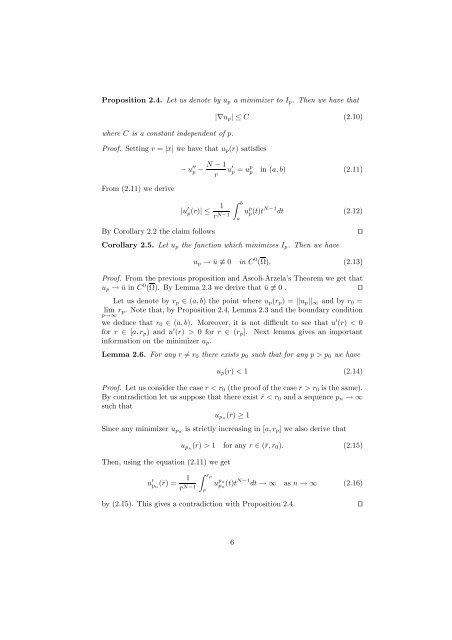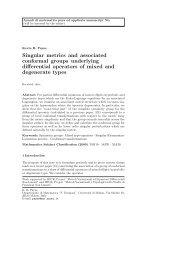Asymptotic behaviour of the Kazdan-Warner solution in the annulus ∗
Asymptotic behaviour of the Kazdan-Warner solution in the annulus ∗
Asymptotic behaviour of the Kazdan-Warner solution in the annulus ∗
Create successful ePaper yourself
Turn your PDF publications into a flip-book with our unique Google optimized e-Paper software.
Proposition 2.4. Let us denote by up a m<strong>in</strong>imizer to Ip. Then we have that<br />
where C is a constant <strong>in</strong>dependent <strong>of</strong> p.<br />
Pro<strong>of</strong>. Sett<strong>in</strong>g r = |x| we have that up(r) satisfies<br />
From (2.11) we derive<br />
− u ′′<br />
p<br />
|∇up| ≤ C (2.10)<br />
N − 1<br />
− u<br />
r<br />
′ p = upp <strong>in</strong> (a, b) (2.11)<br />
|u ′ p(r)| ≤ 1<br />
r N−1<br />
b<br />
u p p(t)t N−1 dt (2.12)<br />
By Corollary 2.2 <strong>the</strong> claim follows ⊓⊔<br />
Corollary 2.5. Let up <strong>the</strong> function which m<strong>in</strong>imizes Ip. Then we have<br />
a<br />
up → ū ≡ 0 <strong>in</strong> C 0 (Ω). (2.13)<br />
Pro<strong>of</strong>. From <strong>the</strong> previous proposition and Ascoli-Arzela’s Theorem we get that<br />
up → ū <strong>in</strong> C 0 (Ω). By Lemma 2.3 we derive that ū ≡ 0 . ⊓⊔<br />
Let us denote by rp ∈ (a, b) <strong>the</strong> po<strong>in</strong>t where up(rp) = ||up||∞ and by r0 =<br />
lim<br />
p→∞ rp. Note that, by Proposition 2.4, Lemma 2.3 and <strong>the</strong> boundary condition<br />
we deduce that r0 ∈ (a, b). Moreover, it is not difficult to see that u ′ (r) < 0<br />
for r ∈ [a, rp) and u ′ (r) > 0 for r ∈ (rp]. Next lemma gives an important<br />
<strong>in</strong>formation on <strong>the</strong> m<strong>in</strong>imizer up.<br />
Lemma 2.6. For any r = r0 <strong>the</strong>re exists p0 such that for any p > p0 we have<br />
up(r) < 1 (2.14)<br />
Pro<strong>of</strong>. Let us consider <strong>the</strong> case r < r0 (<strong>the</strong> pro<strong>of</strong> <strong>of</strong> <strong>the</strong> case r > r0 is <strong>the</strong> same).<br />
By contradiction let us suppose that <strong>the</strong>re exist ¯r < r0 and a sequence pn → ∞<br />
such that<br />
upn(¯r) ≥ 1<br />
S<strong>in</strong>ce any m<strong>in</strong>imizer upn is strictly <strong>in</strong>creas<strong>in</strong>g <strong>in</strong> [a, rp] we also derive that<br />
Then, us<strong>in</strong>g <strong>the</strong> equation (2.11) we get<br />
upn(r) > 1 for any r ∈ (¯r, r0). (2.15)<br />
u ′ 1<br />
pn (¯r) =<br />
¯r N−1<br />
rp<br />
u<br />
¯r<br />
pn<br />
pn (t)tN−1dt → ∞ as n → ∞ (2.16)<br />
by (2.15). This gives a contradiction with Proposition 2.4. ⊓⊔<br />
6








